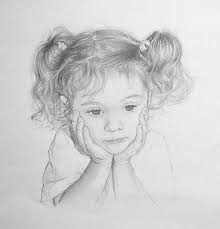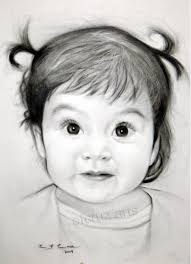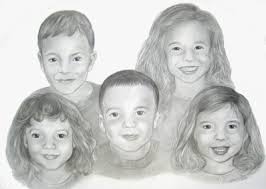Source:Google.com.pk
Pencil Drawing Pictures For Kids Biography
When he spoke about his new book Wonderstruck at Book Expo America, Brian Selznick said that he wanted to take what he'd learned from writing and illustrating The Invention of Hugo Cabret to a higher level with this new work. I am happy to report that Selznick has done exactly that. Like Hugo, for which he was awarded the Caldecott Medal, Wonderstruck is fiction for middle grade readers and others who appreciate good stories told in both words and pictures.
Wonderstruck: The Unique Format
Traditional picture books are generally about 32 pages with both illustrations and words on every double-page spread that together tell a story for younger children. However, like The Invention of Hugo Cabret, Selznick's new work of children's fiction is a picture book for children 9-12 and young teens that is hundreds of pages long and uses many of those pages for wordless sequential art to tell the story. What's different in Wonderstruck is that there are two separate stories, set fifty years apart, one told with words only and one told with illustrations only, until near the end of the book.
The Illustrations
Wonderstruck is more than 630 pages long and included in that are more than 460 pages of illustrations. Brian Selznick's dense pencil drawings are created with pencil on watercolor paper. The movie-like quality of the illustrations comes from the way Selznick treats the sequences of illustrations, panning a scene, moving in for a close-up and viewing scenes from multiple angles, just as a movie maker would.
Wonderstruck: The Stories
In Wonderstruck, Brian Selznick tells the story of Rose, a girl living in Hoboken, New Jersey in 1927 completely in pictures, and the story of Ben, a boy living in 1977 in Gunflint Lake, Minnesota, completely in words, until the two stories come together in 1977 and Rose and Ben meet and learn how their stories connect them to one another.
Both Rose and Ben feel isolated and alone. Both are deaf and both are seeking something.
It's October, 1927. Rose is completely deaf. Her parents are divorced. Rose has no knowledge of Deaf culture and is kept at home with her somewhat distant father and is allowed little interaction with the outside world. She is being tutored in lip-reading and speaking but misses a tutoring session and cuts up the book to make models of skyscrapers. Why did she do that?
There are a lot of other things the reader wonders about, too. Why is Rose so interested in the actress Lillian Mayhew that she has filled a scrapbook with clippings about her and sneaks out of the house to see her latest silent movie?
What does Rose mean when she writes, "Help me" on a piece of paper, climbs out the window of her New Jersey home, runs to the banks of the nearby river, folds the paper into a boat shape and launches it in the water towards New York City? Why does she run away to the city? Who is Walter? Little by little, the mysteries are solved as the reader comes to know more about Rose and the people who are important to her.








Pencil Drawing Pictures For Kids Biography
When he spoke about his new book Wonderstruck at Book Expo America, Brian Selznick said that he wanted to take what he'd learned from writing and illustrating The Invention of Hugo Cabret to a higher level with this new work. I am happy to report that Selznick has done exactly that. Like Hugo, for which he was awarded the Caldecott Medal, Wonderstruck is fiction for middle grade readers and others who appreciate good stories told in both words and pictures.
Wonderstruck: The Unique Format
Traditional picture books are generally about 32 pages with both illustrations and words on every double-page spread that together tell a story for younger children. However, like The Invention of Hugo Cabret, Selznick's new work of children's fiction is a picture book for children 9-12 and young teens that is hundreds of pages long and uses many of those pages for wordless sequential art to tell the story. What's different in Wonderstruck is that there are two separate stories, set fifty years apart, one told with words only and one told with illustrations only, until near the end of the book.
The Illustrations
Wonderstruck is more than 630 pages long and included in that are more than 460 pages of illustrations. Brian Selznick's dense pencil drawings are created with pencil on watercolor paper. The movie-like quality of the illustrations comes from the way Selznick treats the sequences of illustrations, panning a scene, moving in for a close-up and viewing scenes from multiple angles, just as a movie maker would.
Wonderstruck: The Stories
In Wonderstruck, Brian Selznick tells the story of Rose, a girl living in Hoboken, New Jersey in 1927 completely in pictures, and the story of Ben, a boy living in 1977 in Gunflint Lake, Minnesota, completely in words, until the two stories come together in 1977 and Rose and Ben meet and learn how their stories connect them to one another.
Both Rose and Ben feel isolated and alone. Both are deaf and both are seeking something.
It's October, 1927. Rose is completely deaf. Her parents are divorced. Rose has no knowledge of Deaf culture and is kept at home with her somewhat distant father and is allowed little interaction with the outside world. She is being tutored in lip-reading and speaking but misses a tutoring session and cuts up the book to make models of skyscrapers. Why did she do that?
There are a lot of other things the reader wonders about, too. Why is Rose so interested in the actress Lillian Mayhew that she has filled a scrapbook with clippings about her and sneaks out of the house to see her latest silent movie?
What does Rose mean when she writes, "Help me" on a piece of paper, climbs out the window of her New Jersey home, runs to the banks of the nearby river, folds the paper into a boat shape and launches it in the water towards New York City? Why does she run away to the city? Who is Walter? Little by little, the mysteries are solved as the reader comes to know more about Rose and the people who are important to her.
Pencil Drawing Pictures For Kids
Pencil Drawing Pictures For Kids
Pencil Drawing Pictures For Kids
Pencil Drawing Pictures For Kids
Pencil Drawing Pictures For Kids
Pencil Drawing Pictures For Kids
Pencil Drawing Pictures For Kids
Pencil Drawing Pictures For Kids
Pencil Drawing Pictures For Kids
Drawing For Kids Introduction
Drawing For Kids
No comments:
Post a Comment